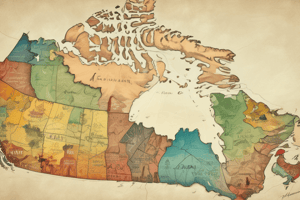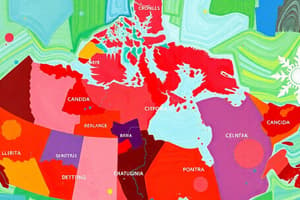Podcast
Questions and Answers
What is the likely origin of the name 'Yukon'?
What is the likely origin of the name 'Yukon'?
- It comes from the Viking word for 'great river'
- It is derived from the Huron-Iroquois word for 'village'
- It originates from the Inuit word for 'westernmost point'
- It comes from the Gwich'in word meaning 'great river' (correct)
Which European group made early contact with the people of Canada?
Which European group made early contact with the people of Canada?
- Spanish explorers
- Roman settlers
- Vikings (correct)
- Portuguese traders
What percentage of Canada's population consists of indigenous people?
What percentage of Canada's population consists of indigenous people?
- 15%
- 20%
- 10%
- 5% (correct)
When did Canada become its own country?
When did Canada become its own country?
What is the term used for the government structure of Canadian provinces and territories similar to American states?
What is the term used for the government structure of Canadian provinces and territories similar to American states?
What is the primary difference between Canadian provinces and territories?
What is the primary difference between Canadian provinces and territories?
In what city is the capital of Canada located?
In what city is the capital of Canada located?
How many provinces and territories are there in Canada?
How many provinces and territories are there in Canada?
Which part of Canada are the territories primarily located?
Which part of Canada are the territories primarily located?
How have the territories of Canada evolved in terms of rights and responsibilities compared to the provinces?
How have the territories of Canada evolved in terms of rights and responsibilities compared to the provinces?
Which province of Canada has its own time zone that is half an hour ahead of another province?
Which province of Canada has its own time zone that is half an hour ahead of another province?
What is the meaning of the word 'Manitoba' according to the text?
What is the meaning of the word 'Manitoba' according to the text?
Which Canadian province is known for its distinctive French-Canadian culture?
Which Canadian province is known for its distinctive French-Canadian culture?
Which territory in Canada was formed in 1999 and means 'our land' in Inuktitut?
Which territory in Canada was formed in 1999 and means 'our land' in Inuktitut?
Which Canadian province has the biggest Métis population?
Which Canadian province has the biggest Métis population?
Flashcards are hidden until you start studying
Study Notes
Canadian Geography and History
- The origin of the name 'Yukon' is likely from the Gwich'in language, meaning 'great river'.
- The first European group to make contact with the indigenous people of Canada were the Vikings.
Indigenous Population
- Indigenous people make up around 4.9% of Canada's population.
Canadian Independence
- Canada gained independence from British rule on July 1, 1867.
Government Structure
- The government structure of Canadian provinces and territories is similar to that of American states, with each province and territory having its own administration.
- The primary difference between Canadian provinces and territories lies in their autonomy and powers, with provinces having more powers than territories.
Capitals and Territories
- The capital of Canada is located in Ottawa.
- There are 10 provinces and 3 territories in Canada.
- The territories are primarily located in the north of Canada.
Territorial Evolution
- Over time, the territories of Canada have gained more rights and responsibilities, bringing them closer to the provinces in terms of autonomy.
Provincial Facts
- The province of Newfoundland and Labrador has its own time zone, which is half an hour ahead of the Atlantic Time Zone.
- The word 'Manitoba' means 'the place where the spirit (S Manitou) speaks' in the Cree language.
- Quebec is known for its distinctive French-Canadian culture.
Territorial Facts
- Nunavut is a territory formed in 1999, with its name meaning 'our land' in Inuktitut.
- Manitoba has the biggest Métis population in Canada.
Studying That Suits You
Use AI to generate personalized quizzes and flashcards to suit your learning preferences.




